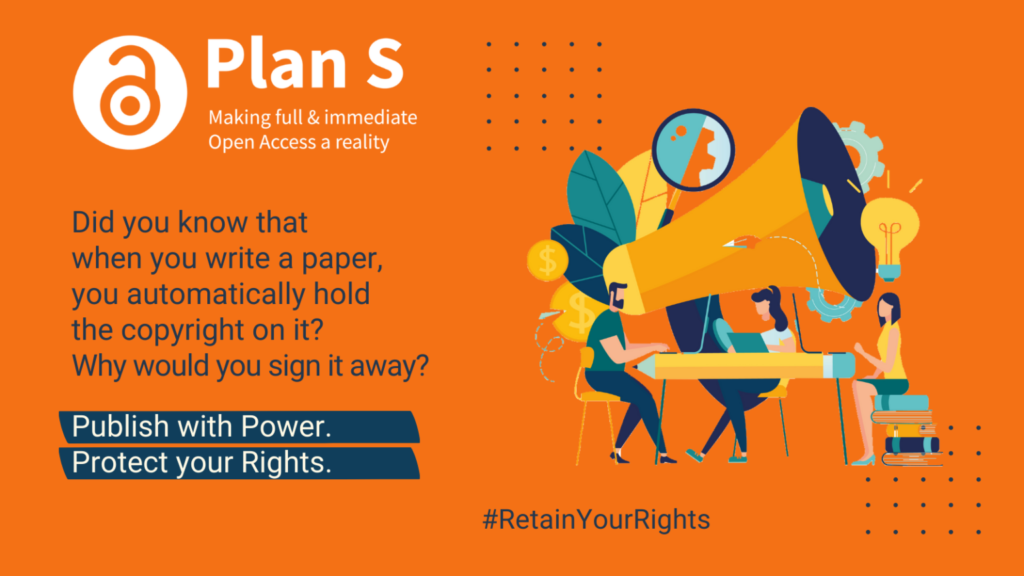
Publishing open access (OA) can be more challenging for members of the pharma community than for others. Some publishers simply do not allow authors with pharmaceutical industry affiliations to select an OA option, meaning that the publishers can continue to profit from access to, and reuse of, the work. Luckily, there are things that authors can do, irrespective of their affiliation, to take back control.
Rights retention
The ‘why?’
When publishing their research, authors typically sign away most (or all) of their rights to their work in return for the privilege of journal publication. Signing over their rights to the article allows the journal publisher to collect revenue from accesses to that article, reprints, translations, and reuse of any elements in the article. Even the authors who wrote the article often have to pay to access their own publication, or pay for reuse rights for an article figure, table, or other component that was signed away to the publisher.
However, authors (or the organizations they work for) are the original copyright holders on the articles they write. They can assert this right by assigning a license to the paper when submitting it to a publisher. Institutions that advocate for rights retention, such as cOAlition S, require that this right be asserted as a CC BY license or equivalent. The CC BY license means that the author allows for the publication to be built upon and used by others as they see fit, provided that appropriate credit is given to the original publication. It also allows authors to reuse and share parts of their paper at their own discretion. As such, the CC BY license is a close approximation of traditional academic practice. Once assigned to an article, the CC BY license becomes an inherent element of that publication and cannot be changed by a subsequent contract with a publisher. Rights retention is, therefore, a strong instrument that ensures the author (or organization) has sufficient ownership over the contents.
The ‘how?’
Below are the steps required to implement a rights retention strategy in your organization.
- Develop an institutional rights retention policy (IRRP), making rights retention an internal policy of the organization and a condition of labor. The advantage of an IRRP is that it protects and reinforces the position of individual researchers in their interactions with publishers. About 20 universities in the UK and Norway have now adopted such IRRPs. Details of how these organizations implemented IRRPs can be found on the cOAlition S blog pages.
- Adapt the text below to reflect your organizational needs, and ask the authors in your organization to use it with every submission, particularly to journals that still have paywalls:
“This research was funded in whole or in part by [Organization]. For the purpose of Open Access, the author has applied a CC BY public copyright license to any Author Accepted Manuscript (AAM) version arising from this submission.”
| Note: We highly recommend that you upload a preprint version of your article to a preprint repository before submission, with the CC BY license details clearly stated in it. This also helps to protect your rights to your work. |
- Upon article acceptance upload your author accepted manuscript to an OA repository with a CC BY license. If you need help with this, there is useful guidance on ShareYourPaper.org.
Pros
- Authors retain the rights to their work to share, remix, and reuse.
- Rights retention ensures that there is an OA version of an article if the journal does not offer an OA route or the author processing charges (APCs) are exorbitant.
- It is a low cost and more equitable way to achieve OA than paid OA/APC routes.
Cons
- A journal can outright reject the article based on the inclusion of rights retention language. This is incredibly rare as far as we know and, in our opinion, would mark the journal out as one to be avoided for its anti-OA and open science practices.
- When you submit a paper with a CC BY license, some journal publisher may try to force you down the paid OA/APCs route. This removes author choice and should not be tolerated. If the publisher does not leave you a choice, we recommend that you withdraw the article and submit it elsewhere; the availability of an article in OA trumps journal prestige in the eyes of cOAlition S funders.
Transformative agreements
The ‘why?’
‘Transformative agreement’ (TA) is an umbrella term used to describe contracts between institutions and publishers intended to transform the current (primarily subscription-based) journal publishing model to a fully OA model.1 A fully OA model is preferred by libraries that support communities with both access and publication needs.
The ‘how?’
Work directly with publishers to negotiate a bulk contract that covers your organization’s publications for a fixed number of years.
Pros
- OA options and licensing can be negotiated and realized via a single contract.
- Publications costs can be covered centrally.
Cons
- There is very little evidence that TAs are indeed transformative and are actually changing the OA model to be more equitable and sustainable.
- Dividing the price of a TA by the number of articles it covers often works out to a very high per-article price that is unaffordable for many countries and organizations, especially in the Global South.
- Publishers prefer to arrange TAs with country-level library consortia. The publication volume of your organization per publisher may be too low to make this model work.
Platform publishing
The ‘why?’
Hosting a publishing platform dedicated to pharma articles can create a central repository of pharma research with journal-like entities/subdivisions that are curated, edited, owned, and controlled by researchers.
The ‘how?’
Work with a known publishing entity or create a bespoke platform to host pharma-funded research in an OA format.
Pros
- Provides a cost-effective, stable OA option for current and future publications.
Cons
- It will take some time before the articles published on these platforms are indexed in the same way as those published in traditional journals.
- This limitation can, however, be mitigated by enlisting prestigious researchers as platform editors.
- Having an in-house platform, or a platform supported by the pharma community, may draw criticism and suggestions of vanity publishing by the pharma industry of research that has not been subject to external review or validation.
- A possible means of mitigating such accusations would be to set up a foundation financed by, but otherwise independent of, the pharma industry. The foundation would own the platform but it would be managed by researchers from the academic and pharma communities who would provide both visibility and independence.
Reference
- Farley A et al. Transformative agreements: Six myths, busted. College & Research Libraries News 2021;82:298; doi.org/10.5860/crln.82.7.298.
Ashley Farley is a Program Officer of Knowledge and Research Services at the Bill & Melinda Gates Foundation. In this capacity, she leads the Foundation’s Open Access Policy’s implementation and associated initiatives. This includes leading the work of Gates Open Research, a transparent and revolutionary publishing platform.
Johan Rooryck is the Executive Director of cOAlition S and Co-Editor-in-Chief of the Diamond Open Access journal, Glossa: a journal of general linguistics since 2016. He is a member of the Academia Europaea, a doctor honoris causa of UiT – The Arctic University of Norway, and a visiting professor at Leiden University, where he held the chair of French linguistics from 1993 to 2020.






